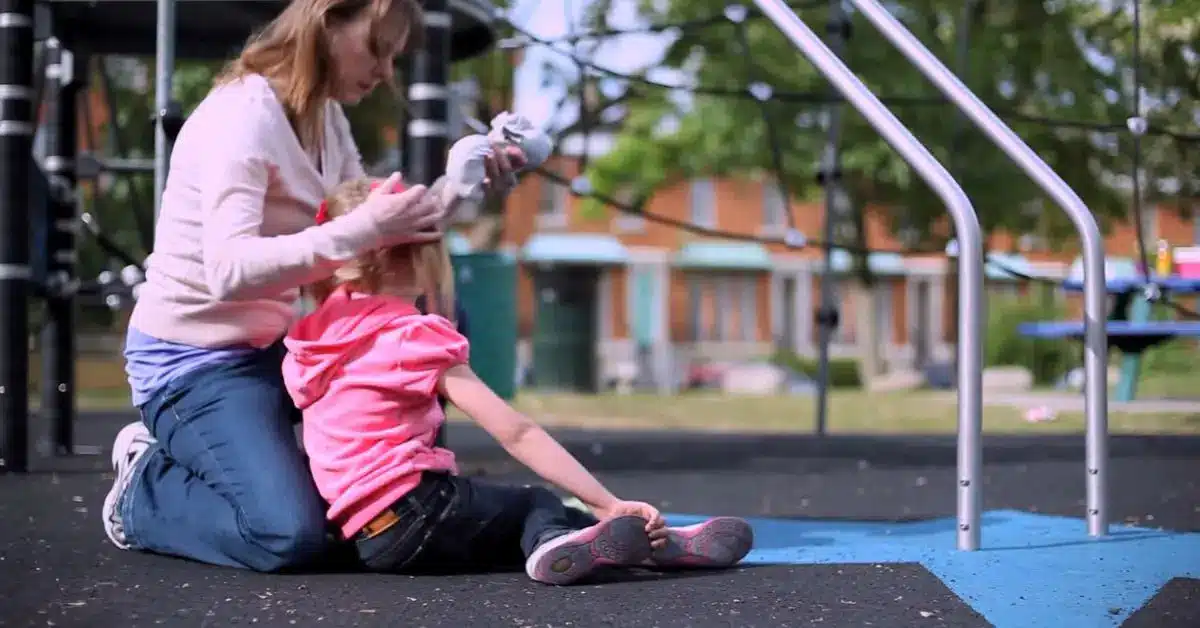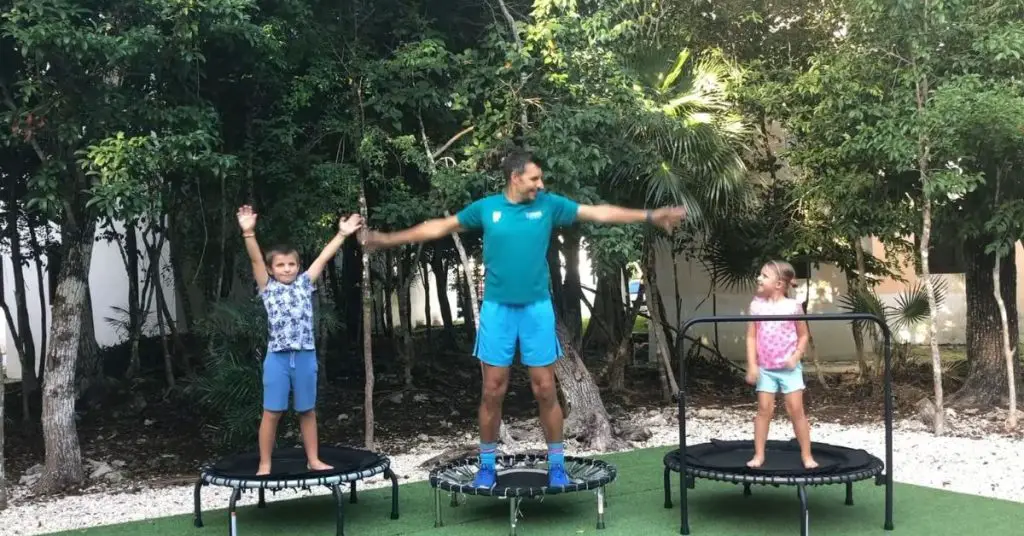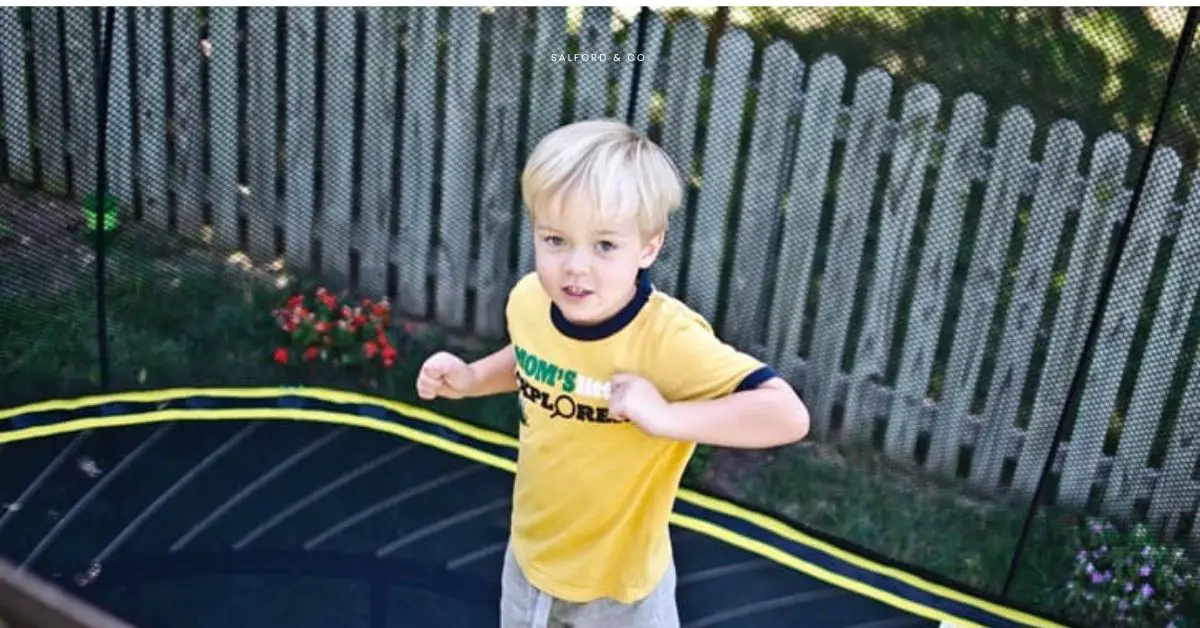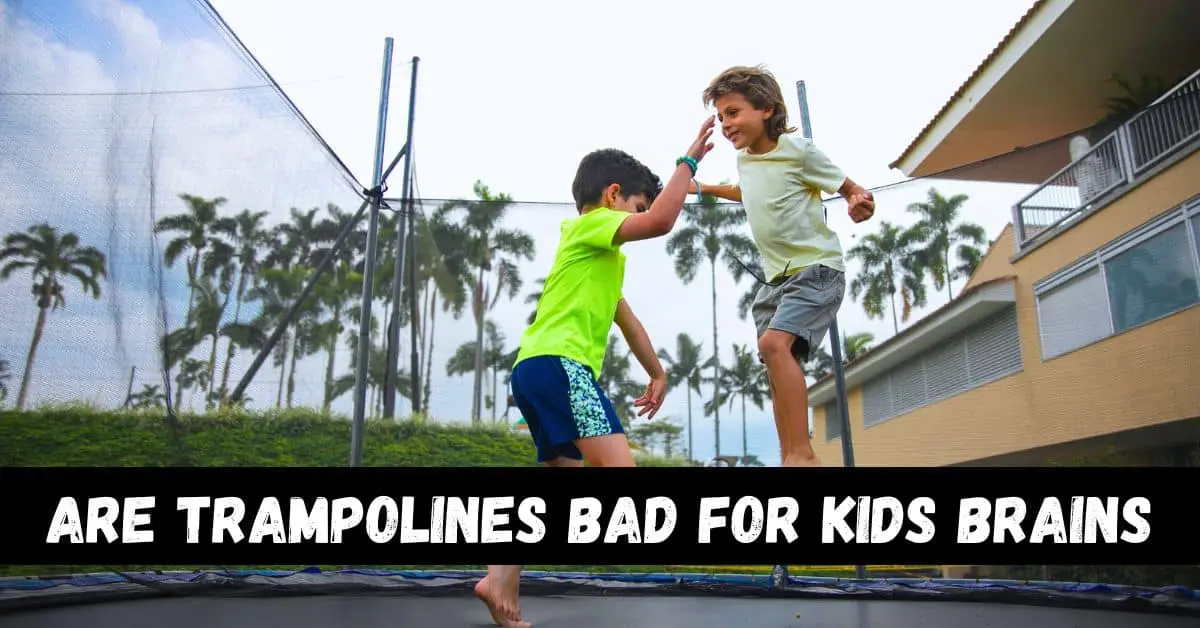Trampolines have long been a popular recreational activity for children, offering them an opportunity for outdoor play and physical exercise. However, concerns have been raised regarding the potential impact of trampoline use on children’s brains.
As parents and guardians, it is natural to prioritize the well-being and cognitive development of our children. Therefore, understanding the potential risks and benefits associated with trampolines is crucial in making informed decisions about their use.
The human brain, particularly that of a developing child, is a delicate and complex organ. Any activity that involves physical impact and movement can potentially pose risks.
Some studies suggest that the repetitive bouncing and sudden changes in movement patterns on trampolines may lead to head injuries, concussions, or other traumatic brain injuries.
These concerns have sparked debates among healthcare professionals, researchers, and parents, highlighting the need for a comprehensive examination of the potential effects of trampolines on children’s brains.
In this article, we will delve into the existing research and provide an overview of the arguments surrounding the question: Are trampolines bad for kids’ brains?
By exploring the available evidence, we aim to shed light on this important topic and help parents and guardians make informed decisions about their children’s participation in trampoline activities.
Are trampolines bad for kids brains: The potential impact of trampoline use on kids’ brains raises concerns due to the risk of head injuries and concussions. Understanding the risks is essential for informed decision-making.
Trampolines have gained immense popularity as a source of outdoor fun and physical activity for kids. However, concerns have been raised regarding the potential impact of trampoline use on children’s brains.
It is natural for parents and guardians to be concerned about their children’s cognitive health and well-being.
Are Trampolines Bad For Kids Brains?

The primary concern associated with trampoline use is the risk of head injuries and concussions. The repetitive bouncing and sudden changes in movement patterns can increase the likelihood of falls and collisions, which may result in traumatic brain injuries.
While the overall risk of these injuries is relatively low, it is essential to take precautions and follow safety guidelines to minimize potential risks.
To ensure the safety of children using trampolines, adult supervision is crucial. Proper padding, enclosure nets, and adherence to safety rules such as one user at a time can significantly reduce the risk of accidents.
Additionally, it is important to consider factors such as the child’s age, physical abilities, and maturity level before allowing trampoline use.
While trampolines can offer physical exercise and enjoyment, it is essential to strike a balance between fun and safety. Parents and guardians should make informed decisions by considering the potential risks, following safety guidelines, and closely monitoring their children’s trampoline activities.
Benefits of Trampolines
Trampolines have gained immense popularity among children in recent years. These bouncy devices not only provide a fun way to spend time outdoors but also offer numerous physical and mental benefits.
From improved balance and coordination to enhanced cardiovascular fitness, trampolines can contribute positively to a child’s overall well-being.
Additionally, trampolines can have a positive impact on mental health, providing stress relief and improving mood. Let’s explore these benefits in detail.
Physical Benefits
Here are the physical benefits of trampolines for children:
Improved Balance:
Trampolines require constant adjustments in body position and weight distribution. Jumping on a trampoline helps children develop a keen sense of balance as they try to maintain stability while bouncing.
Enhanced Coordination:
The rhythmic bouncing motion on a trampoline requires children to synchronize their movements, improving their hand-eye coordination and overall motor skills.
The repetitive jumping action encourages children to time their jumps accurately, honing their ability to coordinate movements effectively.
Increased Cardiovascular Fitness:
Jumping on a trampoline is a fantastic cardiovascular exercise. It gets the heart rate up and stimulates the circulatory system, leading to improved cardiovascular health. Regular trampoline use can help children build endurance, stamina, and overall cardiovascular fitness.
Strengthened Muscles and Bones:
Trampolining engages various muscle groups throughout the body, including the legs, core, and upper body. The repetitive bouncing motion strengthens these muscles, contributing to overall muscle development.
Moreover, the impact of the jumping action helps promote bone density and growth, making trampolines particularly beneficial for children in their developmental years.
Mental Health Benefits
Trampolines not only offer physical benefits but also have positive effects on children’s mental health. The following are some of the mental health benefits associated with trampoline use:
Stress Relief:
Jumping on a trampoline can provide an excellent outlet for releasing pent-up energy and stress. The rhythmic bouncing motion combined with the exhilarating feeling of being airborne can help children let go of stress and tension, promoting relaxation and a sense of well-being.
Improved Mood:
Physical activity, including trampolining, stimulates the release of endorphins, which are known as “feel-good” hormones. These endorphins can uplift a child’s mood, reducing feelings of anxiety and depression. Regular trampoline use can contribute to a more positive and cheerful disposition in children.
Increased Self-Esteem and Confidence:
Mastering new skills on a trampoline, such as learning different jumps or performing tricks, can boost a child’s self-esteem and confidence. Overcoming challenges and seeing progress in their abilities can empower children and foster a sense of accomplishment.
Social Interaction: Trampolining can be a social activity, particularly when children engage in it with friends or family members. Jumping together on a trampoline encourages communication, cooperation, and teamwork, helping children develop social skills and form stronger bonds with others.
It is important to note that while trampolines offer numerous benefits, safety considerations should always be a top priority. Adult supervision, proper safety measures, and adherence to guidelines, such as limiting the number of jumpers and ensuring a safe jumping surface, are crucial to prevent accidents and injuries.
Potential Risks and Concerns
Trampolines can provide numerous physical and mental benefits for children, but it is important to be aware of the potential risks and concerns associated with their use. While trampolining can be an enjoyable activity, accidents, and injuries can occur, with particular concern for head injuries.
Understanding these risks and taking appropriate safety measures can help mitigate potential harm. Let’s explore these potential risks and concerns in more detail.
Accidents and Injuries

Sprains and Fractures: Jumping on a trampoline involves various movements and landings, which can put stress on the joints and bones.
As a result, children may experience sprains, strains, or even fractures if they land awkwardly or collide with other jumpers.
Collisions and Falls: Trampolines are often shared among multiple jumpers. Collisions between jumpers can lead to injuries, including bumps, bruises, and even more severe injuries if there is a significant impact. Additionally, falls from the trampoline onto the ground or surrounding objects can result in injuries.
Pinching and Entrapment: The springs or frames of trampolines may pose a risk of pinching or entrapment for children’s fingers, toes, or other body parts. This can lead to minor injuries, such as cuts or bruises, or more serious injuries if not properly addressed.
Head Injuries and Brain Health
Concussions: Head injuries, including concussions, are a significant concern associated with trampoline use. If a child falls awkwardly or collides with another jumper, the impact can result in a head injury.
Concussions can have short-term effects, such as headaches, dizziness, and confusion, and may also have long-term consequences if not managed properly.
Potential Impact on Brain Health:
While the majority of trampoline-related head injuries are not severe, any injury to the head can potentially impact brain health. Traumatic brain injuries, even those considered mild, can have long-lasting effects on cognitive functions, memory, and overall brain health.
It is crucial to take head injuries seriously and seek medical attention when necessary.
It is important to note that the risks associated with trampolines can be mitigated by implementing appropriate safety measures and guidelines:
Adult Supervision: Children should always be supervised by a responsible adult while using a trampoline. This ensures that safety rules are followed, and immediate assistance can be provided in case of accidents.
Safety Equipment: Encourage children to use safety equipment, such as helmets and pads, to protect vulnerable areas like the head, knees, and elbows.
Trampoline Design and Maintenance: Ensure that the trampoline is in good condition, with proper padding and a safety net enclosure. Regular maintenance and inspections can help identify any potential hazards.
Limitations and Guidelines: Follow the manufacturer’s guidelines regarding the maximum weight capacity and the number of jumpers allowed on the trampoline. Discourage risky behaviors, such as somersaults and flips, which can increase the risk of injuries.
By being aware of these potential risks and taking appropriate safety precautions, the benefits of trampolines can be maximized while minimizing the likelihood of accidents and injuries.
Understanding Brain Injuries

Traumatic brain injuries (TBIs) are a significant concern when it comes to the safety of children engaging in activities like trampolining.
TBIs occur when there is a sudden jolt or blow to the head that disrupts the normal functioning of the brain.
It is crucial to understand the causes of TBIs, how trampoline accidents can lead to such injuries, and the potential short-term and long-term effects on children’s brains. Let’s explore these aspects in more detail.
Traumatic Brain Injuries (TBI) and their Causes
Traumatic brain injuries (TBI) occur when there is a sudden jolt, blow, or penetrating injury to the head that disrupts the normal functioning of the brain.
TBIs can range from mild concussions to severe injuries, and they can have both short-term and long-term effects on a person’s health. The causes of TBIs are diverse and can include:
Falls: Falls are a leading cause of TBIs, especially in children. When a child falls from a trampoline, whether onto the ground or onto other hard surfaces, the impact can cause the brain to move within the skull, resulting in a TBI.
Collisions: Trampoline accidents involving collisions between jumpers can also lead to TBIs. If two or more individuals collide with each other or land on each other, the forceful impact on the head can cause a TBI.
Improper Landings: Incorrect landings, such as landing on the head or neck, can significantly increase the risk of head injuries. Engaging in risky maneuvers or attempting flips and somersaults without proper training and supervision also raises the likelihood of TBI-inducing accidents.
Trampoline Accidents and TBIs
Trampoline accidents can result in TBIs due to several factors:
Falls: Jumping on a trampoline involves varying heights and unpredictable landings, making falls a common occurrence. When a child loses balance or attempts a challenging jump, they may fall off the trampoline, potentially hitting their head on the ground or other objects nearby.
Collisions: Trampolines often have multiple jumpers simultaneously. Collisions can happen when two or more jumpers accidentally collide with each other in mid-air or during landings. The impact of such collisions can lead to head injuries and TBIs.
Incorrect Landings: Improper landings can occur when a child misjudges their jump or loses control mid-air. If they land on their head or neck, the forceful impact can cause a TBI.
Potential Short-term and Long-term Effects of TBIs on Children’s Brains
Short-term Effects: Immediately following a TBI, children may experience a range of symptoms such as headaches, dizziness, confusion, nausea, and sensitivity to light and noise. These symptoms can affect a child’s ability to concentrate, learn, and engage in daily activities.
Cognitive Effects: TBIs can impact various cognitive functions, including memory, attention, and problem-solving skills. Children may experience difficulties with concentration, organizing thoughts, and processing information. These effects can hinder academic performance and overall cognitive development.
Emotional and Behavioral Effects: TBIs can also have emotional and behavioral consequences. Children who have experienced a TBI may exhibit changes in mood, behavior, and emotional regulation.
They may become irritable, anxious, or experience mood swings. Additionally, some children may struggle with impulse control, leading to impulsive and sometimes risky behavior.
Long-term Effects: While most children recover fully from mild TBIs, severe injuries can have long-lasting effects on brain health. Prolonged or repeated TBIs can increase the risk of developing chronic traumatic encephalopathy (CTE) or other degenerative brain disorders later in life.
These conditions can lead to cognitive decline, memory loss, mood disorders, and other neurological problems.
Preventing TBIs

Supervision: Adult supervision is essential when children are using trampolines.
A responsible adult can ensure that safety guidelines are followed and intervene in case of accidents.
Safety Measures: Implementing safety measures, such as using safety nets, and padding, and ensuring a well-maintained trampoline, can help minimize the risk of TBIs.
Safety nets around the trampoline can prevent falls from occurring while padding on the springs and frames can reduce the impact of collisions and landings.
Age-appropriate Guidelines: It is important to follow age-appropriate guidelines for trampoline use. Young children, especially those under the age of six, are at a higher risk of sustaining TBIs due to their developmental stage and limited coordination.
It is generally recommended that children under the age of six refrain from using trampolines altogether.
Proper Training: Providing children with proper training and guidance on trampoline usage can significantly reduce the risk of accidents. They should be educated on safe jumping techniques, avoiding dangerous maneuvers, and understanding the importance of staying within their skill level.
One Jumper at a Time: To minimize the risk of collisions, it is advisable to allow only one child to use the trampoline at a time. Multiple jumpers increase the chances of accidents and injuries, including TBIs.
Regular Maintenance: Conduct regular inspections of the trampoline to ensure it is in good condition. Check for any loose or damaged parts that could pose a safety hazard. Proper maintenance can help prevent accidents and reduce the risk of TBIs.
Educating Children: Teach children about the potential risks and dangers of trampoline use. Explain the importance of following safety rules and guidelines to protect themselves and prevent TBIs.
In the event of a head injury or suspected TBI, it is crucial to seek immediate medical attention. A healthcare professional can assess the severity of the injury, provide appropriate treatment, and offer guidance for recovery and management of symptoms.
Research and Expert Opinions
Studies on Trampoline-Related Injuries and their Impact on Brain Health
Numerous studies have examined the relationship between trampoline-related injuries and their potential impact on brain health. These studies provide valuable insights into the risks associated with trampoline use and shed light on the importance of injury prevention strategies.
Study on Trampoline Injuries in Children: A study published in the Journal of Pediatric Orthopaedics analyzed trampoline-related injuries in children. The researchers found that head injuries accounted for a significant proportion of the injuries sustained.
They noted that traumatic brain injuries (TBIs) were a particularly concerning outcome of trampoline accidents. The study highlighted the need for improved safety measures and increased awareness among parents and caregivers.
Analysis of Emergency Department Data: Several studies have utilized emergency department data to examine trampoline-related injuries. These studies consistently indicate a high number of injuries, including head injuries and TBIs, associated with trampoline use.
They underscore the importance of implementing preventive measures, such as proper supervision, adherence to safety guidelines, and the use of safety equipment, to mitigate the incidence and severity of these injuries.
Comparison of Injury Rates: Research has also compared injury rates between different trampoline settings. One study compared injuries in home trampolines with those in commercial trampoline parks.
The findings revealed a higher risk of severe injuries, including TBIs, in trampoline parks. This highlights the significance of implementing stringent safety regulations and guidelines for trampoline park operations.
Expert Opinions and Recommendations
Medical professionals and organizations have expressed concerns about trampoline-related injuries and have provided expert opinions and recommendations to ensure the safety of individuals, particularly children, engaging in trampolining activities.
American Academy of Pediatrics (AAP): The AAP strongly discourages the use of trampolines for recreational purposes due to the high risk of injuries, including TBIs. They emphasize that the potential benefits of trampolining do not outweigh the associated risks.
The AAP recommends alternative activities that promote physical fitness without the inherent dangers of trampoline use. They advocate for safer options such as structured sports or activities like swimming and cycling.
Centers for Disease Control and Prevention (CDC): The CDC recognizes the popularity of trampolines but emphasizes the need for injury prevention measures.
They recommend following safety guidelines, such as providing proper supervision, ensuring the use of safety nets and padding, and avoiding risky maneuvers.
The CDC advises against trampoline use by children under the age of six due to their increased vulnerability to injuries.
Expert Statements: Numerous medical professionals, including pediatricians, orthopedic surgeons, and neurologists, have expressed their concerns regarding trampoline-related injuries and their potential impact on brain health.
Experts emphasize the importance of adhering to safety guidelines, using safety equipment, and providing appropriate supervision.
They stress the need for increased awareness among parents, caregivers, and children themselves about the risks associated with trampolines and the potential consequences for brain health.
These research findings and expert opinions collectively underscore the significance of prioritizing safety when engaging in trampolining activities.
While acknowledging the potential benefits of trampolines, medical professionals and organizations advocate caution, proper supervision, and adherence to safety measures to mitigate the risk of injuries, including TBIs.
Safety Measures and Prevention
Trampolines can provide hours of fun and entertainment for both children and adults. However, it is essential to prioritize safety to prevent potential injuries.
By following proper guidelines and implementing preventive measures, individuals can enjoy trampoline use while minimizing the risk of accidents.
This article will outline safety guidelines for trampoline use, emphasizing the importance of adult supervision, proper padding, and enclosure nets. Additionally, it will discuss the significance of regular maintenance, checking for wear and tear, and creating a safe environment.
Safety Guidelines for Trampoline Use

Adult Supervision: It is crucial to have responsible adult supervision whenever children are using a trampoline.
Adults can monitor the activity, enforce safety rules, and intervene if necessary. By actively supervising, they can prevent reckless behavior and minimize the chances of accidents.
Proper Padding: Trampolines should be equipped with adequate padding to cover the frame, springs, and any potential impact areas. The padding should be thick, firm, and in good condition to absorb shocks and reduce the risk of injuries during jumps and landings.
Enclosure Nets: Installing an enclosure net around the trampoline is a vital safety measure. The net acts as a barrier, preventing users from falling off the trampoline and onto the ground.
It is essential to ensure that the enclosure net is securely fastened and in good condition, without any gaps or tears.
Clear Trampoline Area: Keep the trampoline in an open and clear area, away from trees, fences, and other potential hazards. There should be a safe distance between the trampoline and any structures or objects that could pose a risk of collision.
User Guidelines: Educate trampoline users about safety rules and guidelines. Emphasize the importance of jumping one person at a time, avoiding flips and somersaults unless trained, and landing with both feet in the center of the trampoline. Users should refrain from pushing or rough play that could lead to collisions.
Importance of Regular Maintenance and a Safe Environment
Regular Maintenance: Trampolines require regular maintenance to ensure their safety and longevity. Inspect the trampoline regularly, checking for any wear and tear, loose or rusted parts, and damaged or missing springs. Repair or replace any damaged components promptly to maintain optimal safety.
Safe Environment: Create a safe environment around the trampoline. Remove any debris, toys, or other objects from the trampoline area that could cause tripping or falling hazards.
Ensure the ground is level and adequately cushioned with a soft landing surface, such as grass or impact-absorbing material.
Weather Considerations: Do not use the trampoline during inclement weather, such as high winds, rain, or storms. Adverse weather conditions can make the trampoline unstable and increase the risk of accidents.
Cover the trampoline or disassemble it and store it safely during prolonged periods of non-use or extreme weather conditions.
Education and Communication: Regularly educate trampoline users, both children and adults, about the importance of safety measures and preventive practices. Encourage open communication, emphasizing the need to report any concerns, malfunctions, or accidents immediately.
By following these safety guidelines and emphasizing regular maintenance, individuals can enjoy trampoline use while minimizing the risk of injuries.
Adult supervision, proper padding, and enclosure nets provide essential protection during use, while regular inspections and a safe environment contribute to long-term safety. Prioritizing safety ensures that trampoline use remains a fun and enjoyable activity for everyone involved.
Balancing Risks and Benefits
Trampolines provide a fun and engaging activity for people of all ages, but it is essential to carefully consider the potential risks associated with their use.
By weighing these risks against the benefits and making informed decisions, parents and guardians can ensure the safety and well-being of their children.
This article discusses the importance of balancing risks and benefits, emphasizing the need for informed decision-making and considering individual factors when it comes to trampoline use.
Weighing Potential Risks and Benefits
Risks: Trampolines pose inherent risks, including the potential for falls, collisions, and injuries. Sprains, fractures, and head injuries are among the most common trampoline-related accidents. It is crucial to understand and acknowledge these risks to make informed decisions about trampoline use.
Benefits: Trampolines offer numerous benefits, both physical and psychological. Regular trampoline use can improve cardiovascular fitness, coordination, balance, and strength. It also provides an enjoyable form of exercise and promotes outdoor play and social interaction.
Informed Decision-Making: When considering trampoline use, it is vital to make informed decisions based on a thorough understanding of the risks and benefits. Educate yourself about trampoline safety guidelines, proper usage techniques, and potential risks associated with various activities.
Consider consulting with medical professionals, physical therapists, or trainers who can provide guidance based on individual circumstances.
Supervision and Safety Measures: Adequate supervision and adherence to safety measures significantly reduce the risk of trampoline-related injuries. Ensure that responsible adults are present to supervise trampoline activities, enforce safety rules, and provide immediate assistance if necessary.
Proper padding, enclosure nets, and following guidelines such as one user at a time also contribute to a safer trampoline experience.
Considering Individual Factors

Age and Maturity: Age plays a crucial role in determining whether a child is ready for trampoline use.
Younger children may have less developed motor skills and coordination, increasing their susceptibility to injuries.
Consider the child’s maturity level and ability to follow safety rules and guidelines. Children under the age of six are generally at a higher risk of injuries and should be closely supervised.
Physical Abilities: Evaluate the child’s physical abilities and fitness level before allowing trampoline use. Children with pre-existing medical conditions, balance or coordination issues, or musculoskeletal problems may be at a higher risk of injuries. Consult with healthcare professionals to assess the child’s suitability for trampoline activities.
Individual Circumstances: Consider individual circumstances, such as the size and quality of the trampoline, the available space for safe use, and the overall safety of the environment.
Ensure that the trampoline is appropriate for the child’s age and weight and that it is properly maintained and in good condition.
Alternative Activities: If trampoline use is deemed unsuitable or the risks outweigh the benefits for a particular child, consider alternative activities that provide similar benefits without the associated risks.
Activities such as cycling, swimming, gymnastics, or team sports can offer opportunities for physical exercise, skill development, and social interaction.
By balancing the potential risks and benefits of trampoline use, making informed decisions, and considering individual factors such as age, maturity, and physical abilities, parents and guardians can create a safer environment for their children.
It is essential to prioritize the well-being and safety of children while also allowing them to engage in activities that promote physical fitness and enjoyment.
FAQs
Q.1 Is jumping on a trampoline bad for your brain?
Jumping on a trampoline carries the risk of head injuries, including concussions. While the likelihood of such injuries is relatively low, it is essential to exercise caution and follow safety guidelines to minimize potential risks.
Q.2 Can a trampoline cause shaken baby syndrome?
Trampolines are not associated with shaken baby syndrome. Shaken baby syndrome typically occurs when an infant or young child is forcefully shaken, causing severe brain injury. Trampoline use does not involve the same mechanism of injury.
Q.3 Are trampolines good for ADHD kids?
Trampolines can offer benefits for children with ADHD. Jumping on a trampoline can help improve focus, attention, and sensory integration. However, it is crucial to provide proper supervision and safety measures to ensure a safe experience.
Q.4 What age should a kid get a trampoline?
The recommended age for trampoline use varies. Some experts suggest a minimum age of six, while others recommend waiting until children are older. Ultimately, the decision should consider the child’s physical abilities, maturity, and adherence to safety guidelines.
Q.5 Can kids go to the Get Air trampoline park without parents?
The policy regarding children at Get Air trampoline parks may vary. Generally, trampoline parks require parental supervision for young children, typically under a certain age. It is advisable to check with the specific trampoline park for their age and supervision policies.
Q.6 How expensive is liability insurance for a kids’ trampoline park?
The cost of liability insurance for a kids’ trampoline park depends on various factors, including the park’s size, location, safety measures, and claims history. It is recommended to contact insurance providers for accurate quotes tailored to specific circumstances.
Q.7 How many kids can fit in a 10-foot trampoline?
A 10-foot trampoline is typically designed for one user at a time. It is not recommended to allow multiple children to jump simultaneously on a trampoline of this size due to the increased risk of collisions and injuries.
Q.8 How many kids can jump on a 12-foot trampoline?
A 12-foot trampoline is generally suitable for one or two users at a time. It is crucial to follow the manufacturer’s guidelines regarding weight limits and occupancy to ensure the safety of the children using the trampoline.
Q.9 How many kids can jump on an 8-foot trampoline?
An 8-foot trampoline is typically designed for one user at a time. It is not recommended to allow multiple children to jump simultaneously on an 8-foot trampoline due to the limited space and increased risk of injuries.
Conclusion
In conclusion, when evaluating whether trampolines are bad for kids’ brains, it is important to consider the comprehensive guide provided. Trampolines offer a range of benefits for children, including physical fitness and mental well-being.
However, it is crucial to acknowledge the potential risks and concerns associated with trampoline use, particularly in relation to accidents and injuries.
Head injuries, specifically traumatic brain injuries (TBIs), are a significant concern when it comes to trampoline use. TBIs can have both short-term and long-term effects on children’s brain health.
Preventing TBIs requires implementing safety measures, such as proper supervision, safety guidelines, and regular maintenance of trampolines.
Expert opinions and research contribute to understanding the potential impact of trampolines on brain health. It is vital to balance the risks and benefits by making informed decisions, considering individual factors such as age, maturity, and physical abilities of the child.
By following safety measures, being aware of the potential risks, and considering individual circumstances, parents and guardians can create a safer environment for children to enjoy the benefits of trampoline use while minimizing the potential impact on their brain health.
We hope that after reading this detailed guide on whether trampolines are bad for kids’ brains, you now have a good understanding of the topic. If you have any questions, please feel free to leave a comment below!

